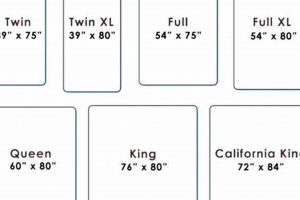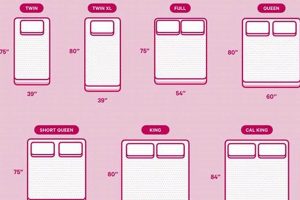The measurements of a futon sleeping surface are critical in determining its compatibility with various frame types and its suitability for diverse user needs. These measurements encompass length, width, and thickness, and vary significantly depending on the intended use whether as a sofa, bed, or both. Standard sizes typically mirror those of traditional mattresses, including twin, full, queen, and king, although slight variations may occur. For example, a full-size configuration generally measures around 54 inches wide and 75 inches long, whereas a queen size is approximately 60 inches wide and 80 inches long.
Proper sizing allows for comfort and functionality, maximizing space utilization in smaller living environments. Historically, these adaptable sleeping solutions have served as both seating and bedding, thereby necessitating dimensional standardization for widespread adoption. Selecting the correct size ensures proper fit within the designated frame, preventing overhang or inadequate support, both of which can compromise comfort and structural integrity. This is particularly important as a stable and supportive sleeping surface is paramount to overall well-being.
Understanding the correlation between standardized frames and the required size for the intended application allows informed consumer choice. Detailed exploration into available sizes and their particular applications offers a more comprehensive understanding of this versatile furnishing option.
Essential Considerations for Futon Mattress Selection
Choosing the correct futon sleeping platform requires careful attention to detail. The following tips will help ensure optimal comfort, fit, and longevity of your investment.
Tip 1: Measure Frame Dimensions Accurately: Before making a purchase, precisely measure the interior dimensions of your futon frame. Discrepancies between frame size and the sleeping surface can lead to uneven wear and reduced comfort.
Tip 2: Consider Intended Use: Determine whether the unit will be primarily used as a sofa, a bed, or both. Frequent use as a bed warrants a thicker, more supportive structure, impacting size considerations.
Tip 3: Evaluate Room Space: Assess the available floor space when the frame is in the open, bed position. Ensure sufficient clearance for movement and avoid obstructing doorways or walkways. Note the complete open size, including the mattress when determining space requirements.
Tip 4: Account for Thickness Variations: Thickness significantly impacts comfort and frame compatibility. A thicker option may not properly fit some frames when in the sofa configuration, hindering the locking mechanism.
Tip 5: Prioritize Density and Support: Higher density materials provide greater support and resistance to compression over time. Test different densities to identify the optimal balance of comfort and firmness.
Tip 6: Review Material Composition: Different materials offer varying degrees of durability and breathability. Consider organic cotton or memory foam for enhanced comfort and longevity.
Tip 7: Understand Weight Capacity: Consult the manufacturer’s specifications regarding weight capacity to prevent premature wear or structural damage. Overloading can compromise support and potentially damage the frame and the mattress.
By carefully considering these critical factors, the optimal futon sleeping platform can be selected, ensuring comfortable and practical utilization for years to come.
A thorough approach to dimension assessment is critical for long-term satisfaction with this versatile furniture choice.
1. Length
Length, as a primary measurement, dictates how well a futon sleeping surface fits a particular frame and provides sufficient sleeping space for an individual or multiple occupants. Its precise measurement is crucial in ensuring the futon’s functionality and user comfort.
- Standard Size Compatibility
Length measurements must align with established mattress sizes like twin (approximately 75 inches), full (approximately 75 inches), queen (approximately 80 inches), or king (approximately 80 inches). A mismatch leads to overhang or insufficient support, impacting the structural integrity of the setup. This directly affects user comfort and lifespan.
- Sofa Configuration Implications
In its sofa configuration, the length, when folded, contributes to the overall depth of the seating area. Insufficient length relative to the frame design can result in an uncomfortable seating posture. In contrast, excess length may cause the sofa to protrude excessively into the room. Consider the overall design.
- Sleeping Accommodation Requirements
The length must accommodate the user’s height to ensure adequate sleeping space. Taller individuals require longer futons to prevent discomfort and interrupted sleep. This involves considering the potential for shared sleeping arrangements, where the cumulative space requirements must be met.
- Frame Mechanism Limitations
Different frames utilize varying conversion mechanisms, which may impose limitations on acceptable length. Certain designs may only accommodate specific lengths to facilitate proper folding and unfolding between sofa and bed configurations. Therefore, length must be aligned with the frame mechanism.
In summation, length within futon specifications directly influences its practical application as both seating and sleeping surfaces. Selection requires careful consideration of frame compatibility, user height, and space constraints within a given environment to maximize utility and comfort.
2. Width
The width dimension of a futon sleeping platform directly dictates its suitability for accommodating one or more occupants and its effectiveness as a seating surface. Accurate assessment of this dimension is critical for optimizing comfort and space utilization.
- Seating Capacity and Comfort
Width directly impacts the number of individuals that can comfortably sit or sleep on the futon. A narrower width may suffice for a single occupant or as a compact seating option, while a wider width is essential for accommodating multiple sleepers or providing generous seating space. Appropriate width also determines ergonomic comfort, preventing overcrowding or a feeling of confinement.
- Frame Stability and Support
Width influences the frame’s structural stability and weight-bearing capacity. An insufficient width, especially in relation to the overall length, can compromise the frame’s ability to evenly distribute weight, potentially leading to sagging or structural failure. Frame construction and materials must be adequate to support the intended width and its associated weight load.
- Room Configuration and Space Optimization
Width considerations are paramount in maximizing available floor space. A wider futon consumes more square footage, potentially restricting movement or limiting the placement of other furniture. Precise measurements of the available space are essential to ensure that the chosen width allows for comfortable use and unobstructed passage within the room. Narrower widths can be advantageous in smaller spaces.
- Material Utilization and Manufacturing Efficiency
The chosen width affects the amount of material required in the construction, subsequently influencing manufacturing costs. Standardized widths align with common material sizes, optimizing material yield and reducing waste. Non-standard widths may necessitate custom material orders, increasing expenses and lead times.
Therefore, width within futon construction directly correlates with occupant capacity, frame stability, room size, and manufacturing economics. Proper selection requires a thorough understanding of these interconnected factors to achieve optimal comfort, longevity, and cost-effectiveness.
3. Thickness
Thickness constitutes a critical dimension affecting the comfort, support, and overall functionality of a futon sleeping platform. It is directly correlated with the futon’s ability to provide adequate cushioning, maintain structural integrity over time, and conform to the specific requirements of its intended frame. A thinner futon mattress may offer limited support and may be more susceptible to compression, resulting in discomfort and premature wear. Conversely, an excessively thick option may encounter compatibility issues with certain frame designs, hindering the folding mechanism or compromising the aesthetics of the sofa configuration. Therefore, a balanced approach that carefully considers the correlation between thickness and its impact on these attributes is essential for optimal performance.
Consider a scenario where a standard-sized futon frame is paired with a mattress significantly exceeding the recommended thickness. The folding mechanism may encounter resistance, preventing the frame from fully locking into the sofa position. Furthermore, excessive thickness can alter the seat height, creating an ergonomic imbalance. Conversely, a thin mattress on the same frame will likely exhibit inadequate support, leading to discomfort during prolonged use as a bed. The ideal thickness strikes a balance, providing sufficient cushioning for sleeping while maintaining compatibility with the frame’s structural constraints and operational mechanics. Actual performance testing and manufacturer specifications should be consulted to determine appropriate thickness ranges.
In conclusion, thickness constitutes an indispensable element within the broader definition of futon mattress dimensions. Its influence extends beyond mere comfort to encompass structural integrity, frame compatibility, and overall usability. Careful consideration of this dimension, guided by empirical data and informed decision-making, ensures the selection of a futon mattress that effectively meets the intended purpose and provides long-term value.
4. Folded Depth
Folded depth, intrinsically linked to overall futon measurements, dictates the space occupied when configured as a sofa. This measurement is a direct consequence of the mattress’s thickness and construction, as it represents the compressed form of the sleeping surface. Increased thickness inherently leads to greater depth when folded. For example, a futon designed for frequent use as a bed necessitates a thicker mattress for enhanced comfort; consequently, its folded depth will be larger, requiring more clearance within a room. The interplay between these parameters must be considered to prevent spatial obstructions and ensure ease of movement within the intended environment. The relationship between overall measurements and the depth when folded is a crucial design and selection parameter.
Furthermore, the materials used in construction significantly impact the final folded depth. Dense materials, even at the same thickness, compress less than less dense ones. This difference can affect the comfort of the seating arrangement. A poorly designed futon with excessive folded depth can result in an uncomfortable seating position, where the seat is too high, and legroom is restricted. In practical applications, measurements and frame designs are often standardized to minimize such ergonomic issues, making the understanding of this direct relationship essential for designers, manufacturers, and consumers. Prior consideration is critical in small living spaces to maximize functionality.
In summary, folded depth is an unavoidable consequence of specific futon dimensions and construction. Accurate evaluation is essential to ensure both spatial compatibility and ergonomic comfort when the futon is used in its sofa configuration. Ignoring this parameter risks compromising the intended benefits, especially in space-constrained environments. Understanding the interplay ensures informed decision-making, optimizing the blend of functionality and comfort for the end-user.
5. Weight
Weight, as a characteristic of a futon sleeping platform, is intrinsically linked to its dimensions. This measurement significantly impacts maneuverability, frame compatibility, and overall user experience. Its relationship to dimensions dictates handling ease, structural requirements, and the practicality of the futon in various settings.
- Material Density and Composition
Weight is directly proportional to the density and composition of the materials used in construction. Higher-density materials, such as memory foam or innerspring coils, contribute to increased weight compared to less dense options like cotton or fiberfill. The material composition influences not only the overall mass but also the level of support and comfort offered. A heavier futon, resulting from denser materials, may provide enhanced support and durability. Examples include high-density foam that offers superior resistance to compression and provides robust support over time.
- Dimensional Proportionality and Distribution
Weight is also governed by the proportionality of dimensions. A larger sleeping surface, characterized by increased length and width, inherently requires more material, thereby increasing the total weight. Uniform distribution of this mass is crucial to prevent sagging or uneven wear. A proportionally designed sleeping platform ensures consistent support across the entire surface, maximizing user comfort and extending the product’s lifespan. For example, even weight distribution prevents weak spots that could lead to premature wear and tear.
- Frame Load Capacity and Compatibility
The weight of the futon sleeping surface must be compatible with the load capacity of the supporting frame. Exceeding the frame’s weight limit can compromise its structural integrity, leading to potential damage or failure. Accurate assessment of both the futon’s weight and the frame’s capacity is essential to ensure safe and reliable operation. Heavy-duty frames constructed from robust materials are recommended for supporting heavier futons, promoting longevity and safety. This also includes considerations for the ease of converting from seating to sleeping configuration.
- Portability and Maneuverability
Weight inversely affects portability and ease of handling. Heavier sleeping surfaces are more challenging to move, transport, and reconfigure. This consideration is particularly relevant in smaller living spaces where frequent repositioning may be necessary. Lighter options offer greater flexibility in terms of arrangement and relocation. Examples of this would include dorm rooms or small apartments, where the ability to move furniture easily is a significant advantage.
In summary, weight, as a function of material density, dimensional proportionality, and frame compatibility, is an important consideration. By carefully balancing these factors, an appropriate choice can be made that meets individual needs, ensuring both comfort and practicality within the intended environment. Accurate understanding of the relationship between weight and other dimensional attributes ensures effective and long-lasting functionality.
6. Material Compression
Material compression, a crucial element in determining the long-term performance and comfort of a futon sleeping surface, exhibits a direct correlation with its physical size. The extent to which the internal materials deform under sustained pressure dictates the supportiveness and longevity of the unit. This deformation is not uniform; it varies based on the composition and density of the core materials, subsequently impacting the overall dimensions and perceived comfort.
- Impact on Thickness Retention
Significant compression leads to a reduction in thickness, thereby diminishing the cushioning effect. Over time, this loss of loft can compromise the support offered by the futon, resulting in an uncomfortable sleeping or seating experience. Materials with high compression resistance, such as high-density foams, exhibit minimal thickness reduction, preserving the intended dimensions and ensuring sustained comfort.
- Influence on Edge Support and Sagging
Differential compression, where certain areas experience more deformation than others, causes uneven support and sagging, particularly along the edges. This localized compression disrupts the intended dimensions, creating an unlevel surface. Proper material selection and construction techniques are vital to mitigate this issue and maintain the structural integrity of the futon.
- Correlation with Dimensional Stability
The extent of compression directly influences the dimensional stability of the futon. Excessive deformation alters the original dimensions, affecting its fit within the frame and its overall aesthetic appeal. Materials that exhibit minimal compression maintain their shape and size over extended periods, ensuring consistent performance and dimensional accuracy.
- Effect on Weight Distribution and Support
Material compression plays a key role in distributing weight evenly across the sleeping surface. Excessive or uneven compression can lead to localized pressure points, disrupting the uniformity of support and potentially causing discomfort or pain. Materials with high compression resistance maintain a consistent level of support throughout the surface, distributing weight effectively and minimizing pressure points.
Therefore, material compression characteristics profoundly impact the long-term performance of futon sleeping platforms. Careful consideration must be given to material selection and construction techniques to minimize deformation and ensure sustained comfort, dimensional stability, and uniform support. The relationship is critical in ensuring a stable, comfortable and lasting surface.
Frequently Asked Questions About Futon Mattress Dimensions
This section addresses common inquiries regarding futon dimensions to facilitate informed decision-making.
Question 1: What are the standard dimensions for a full-size futon mattress?
A full-size futon mattress typically measures approximately 54 inches in width and 75 inches in length. These dimensions may vary slightly depending on the manufacturer.
Question 2: How does futon mattress thickness impact comfort and frame compatibility?
Thickness influences both comfort and compatibility. Excessive thickness may hinder proper folding of the futon frame, while insufficient thickness compromises support and comfort. The ideal thickness should align with frame specifications.
Question 3: Do futon mattress dimensions conform to standard mattress sizes?
While futon sizes generally correspond to standard mattress sizes (twin, full, queen, king), minor dimensional differences may exist. Precise measurements should be verified prior to purchase.
Question 4: What is the significance of folded depth in relation to futon mattress dimensions?
Folded depth determines the space occupied when the futon is configured as a sofa. Increased mattress thickness results in greater folded depth, requiring additional space clearance.
Question 5: How does the weight of a futon mattress correlate with its dimensions and materials?
Weight is influenced by dimensions and material density. Larger and denser mattresses are heavier, affecting maneuverability and frame load capacity. These factors should be taken into account.
Question 6: How does material compression affect the overall dimensions and longevity of a futon mattress?
Material compression reduces thickness and affects support over time. High-quality materials with superior compression resistance maintain dimensional stability and extend the lifespan of the mattress.
In conclusion, understanding the interplay of these dimensional factors ensures optimal selection and satisfaction.
Proceed to the next section for guidelines on choosing the right futon mattress for specific needs.
Futon Mattress Dimensions
The preceding exploration has underscored that knowledge of futon mattress dimensions is paramount to a satisfactory purchase and utilization experience. Dimensional accuracy ensures frame compatibility, maximizes user comfort in both seating and sleeping configurations, and contributes to the furniture’s longevity. Furthermore, material density, weight, and compression characteristics are inextricably linked to these measurements, impacting the overall suitability of the product for specific environments and usage patterns. Failing to account for these dimensional aspects invites potential for premature wear, compromised comfort, and spatial incompatibilities.
Therefore, a comprehensive understanding of futon mattress dimensions, along with their interrelationships, constitutes a necessary prerequisite for effective selection. Prudent consideration of these factors empowers consumers to make informed choices that align with their individual needs and spatial constraints, thereby maximizing the functional value and lifespan of this versatile furniture option. Future advancements in material science and frame design may further optimize the interplay of these factors, enhancing the performance of futons. Consumers should continue to focus on the precise specifications to ensure suitability.







